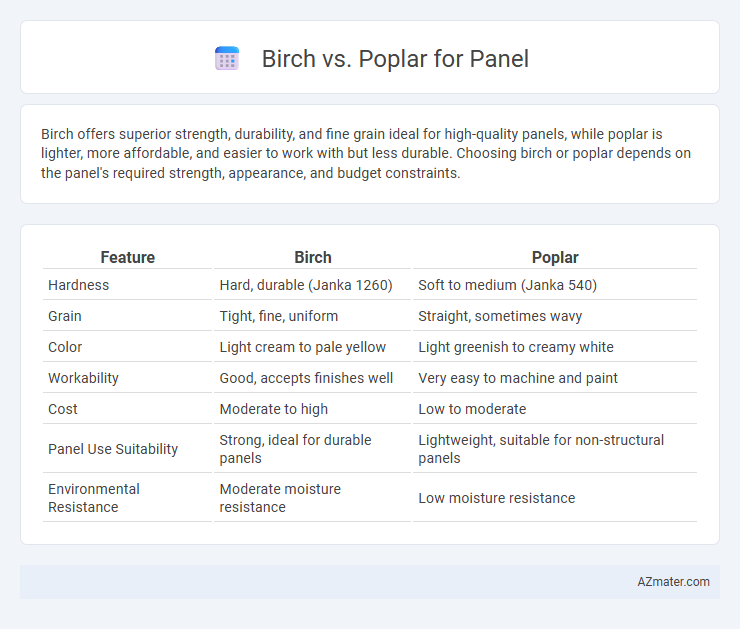Birch offers superior strength, durability, and fine grain ideal for high-quality panels, while poplar is lighter, more affordable, and easier to work with but less durable. Choosing birch or poplar depends on the panel's required strength, appearance, and budget constraints.
Table of Comparison
| Feature | Birch | Poplar |
|---|---|---|
| Hardness | Hard, durable (Janka 1260) | Soft to medium (Janka 540) |
| Grain | Tight, fine, uniform | Straight, sometimes wavy |
| Color | Light cream to pale yellow | Light greenish to creamy white |
| Workability | Good, accepts finishes well | Very easy to machine and paint |
| Cost | Moderate to high | Low to moderate |
| Panel Use Suitability | Strong, ideal for durable panels | Lightweight, suitable for non-structural panels |
| Environmental Resistance | Moderate moisture resistance | Low moisture resistance |
Introduction to Birch and Poplar Panels
Birch panels are valued for their strength, durability, and fine grain, making them ideal for furniture, cabinetry, and flooring applications. Poplar panels, known for their lightweight nature and smooth texture, offer excellent workability and cost-effectiveness, often used in interior projects and painted finishes. Both birch and poplar panels provide versatility, but birch excels in structural stability while poplar stands out for affordability and ease of customization.
Botanical Overview: Birch vs Poplar
Birch (Betula species) is a hardwood known for its fine grain, light color, and durability, commonly used in fine furniture and plywood panels. Poplar (Populus species) is a softer hardwood with a more uniform texture and pale yellowish hue, favored for cost-effective panels and painted surfaces. Both trees belong to the order Malpighiales but differ in growth rate, wood density, and grain patterns, influencing their suitability for various panel applications.
Appearance and Grain Characteristics
Birch panels exhibit a fine, uniform grain with a pale cream to light brown color, often featuring subtle waves or curls that enhance visual texture. Poplar panels display a straighter grain with a more pronounced, sometimes uneven texture and a greenish to yellowish-brown hue that can darken with age. Birch is favored for its consistent smoothness and light tone, while Poplar offers distinctive color variations and a more rustic grain pattern.
Strength and Durability Comparison
Birch panels exhibit superior strength with a Janka hardness averaging 1,260 lbf, making them highly resistant to dents and wear, which contributes to their exceptional durability in construction and furniture applications. Poplar, while softer at about 540 lbf Janka hardness, offers moderate durability but is more prone to dents and surface damage under heavy use. The denser grain structure of Birch provides enhanced load-bearing capacity and longevity compared to the lighter, less dense Poplar panels.
Workability and Machinability
Birch offers superior workability with its fine, uniform grain, allowing for smooth sanding and easy finishing, making it ideal for detailed panel work. Poplar provides excellent machinability due to its softer texture and consistent density, enabling faster cutting and shaping with less wear on tools. Both woods perform well in panel applications, but birch is preferred for high-quality, refined projects, while poplar suits cost-effective, mass-produced panels.
Cost and Availability Analysis
Birch panels generally command higher prices due to their durability and fine grain, making them a premium choice for furniture and cabinetry. Poplar panels offer a more cost-effective alternative with wider availability, favored for its ease of machining and consistent supply in North America and Europe. Cost efficiency and local availability make poplar panels suitable for budget-conscious projects, while birch panels suit applications demanding strength and aesthetic appeal.
Environmental Impact and Sustainability
Birch panels offer a more sustainable option due to their faster growth rates and higher carbon sequestration compared to poplar, which grows quickly but has lower density and durability. Poplar's lighter weight reduces transportation emissions, but its shorter lifespan often leads to more frequent replacement, increasing long-term environmental impact. Choosing birch panels promotes forest management practices that support biodiversity and carbon storage, making them a superior choice for eco-conscious construction.
Common Applications in Paneling
Birch panels are widely used for interior wall paneling, cabinetry, and furniture due to their fine grain, durability, and smooth finish, offering a high-quality aesthetic. Poplar panels are favored in situations requiring easy staining and affordability, commonly used for painted wall panels, molding, and decorative accents. Both woods serve well in paneling but differ in appearance and finishing options, influencing their selection based on project requirements.
Pros and Cons of Birch Panels
Birch panels offer exceptional strength and durability, making them ideal for furniture and cabinetry that require long-lasting support. Their fine grain and pale color provide a smooth, attractive surface that accepts stains and finishes well, enhancing aesthetic versatility. However, birch panels can be more expensive and prone to warping in high humidity compared to poplar, which is more dimensionally stable and affordable but less durable.
Pros and Cons of Poplar Panels
Poplar panels offer a lightweight and cost-effective option with a fine, even grain that supports smooth finishes and easy painting, making them ideal for interior projects and cabinetry. However, poplar lacks the durability and hardness of birch, making it less suitable for high-traffic areas or heavy-use furniture due to its tendency to dent and wear more quickly. The wood's softer nature can affect its resistance to impacts and moisture, limiting its performance in structural applications compared to birch panels.

Infographic: Birch vs Poplar for Panel
 azmater.com
azmater.com